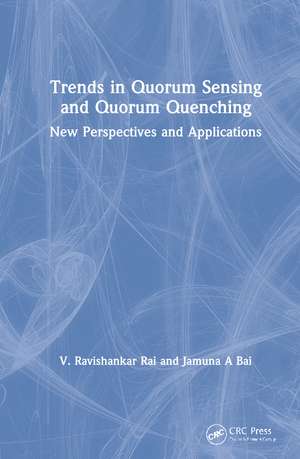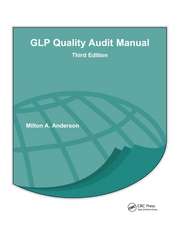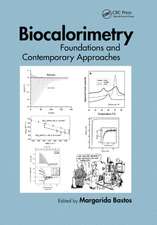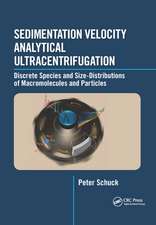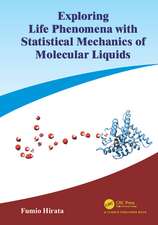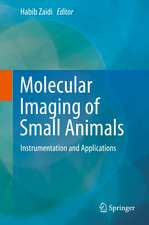Trends in Quorum Sensing and Quorum Quenching: New Perspectives and Applications
Editat de V. Ravishankar Rai, Jamuna A Baien Limba Engleză Hardback – 18 mai 2020
Key features:
- Covers the fundamental aspects, the progress and challenges in the field of quorum sensing and quorum quenching
- Reviews quorum sensing in Gram-positive and Gram-negative bacteria of clinical, agricultural, and industrial relevance
- Discusses the application and future trends of quorum sensing inhibitors from lab to clinical and environmental settings
- Provides comprehensive coverage on molecular mechanisms in bacterial signaling
Preț: 1050.72 lei
Preț vechi: 1446.72 lei
-27% Nou
Puncte Express: 1576
Preț estimativ în valută:
201.12€ • 218.53$ • 169.05£
201.12€ • 218.53$ • 169.05£
Carte tipărită la comandă
Livrare economică 22 aprilie-06 mai
Preluare comenzi: 021 569.72.76
Specificații
ISBN-13: 9780367224288
ISBN-10: 0367224283
Pagini: 406
Ilustrații: 159
Dimensiuni: 210 x 280 mm
Greutate: 0.91 kg
Ediția:1
Editura: CRC Press
Colecția CRC Press
ISBN-10: 0367224283
Pagini: 406
Ilustrații: 159
Dimensiuni: 210 x 280 mm
Greutate: 0.91 kg
Ediția:1
Editura: CRC Press
Colecția CRC Press
Cuprins
1. Expanding Roles and Regulatory Networks of LadS/RetS in Pseudomonas aeruginosa 2. Autoinducer-1 Quorum Sensing Communication Mechanism in Gram-Negative Bacteria 3. Toward a Systematic Genomic Survey of Bacterial Quorum Sensing Genes: Cross Cutting Regulatory and Genomic Concepts 4. Old Acquaintances in a New Role: Regulation of Bacterial Communication Systems by Fatty Acids 5. Analysis of Quorum Sensing by Surface-Enhanced Raman Scattering Spectroscopy 6. Quorum Sensing in Pseudomonas aeruginosa: From Gene and Metabolic Networks to Bacterial Pathogenesis 7. Quorum Sensing in Vibrios 8. Quorum Sensing in Lactic Acid Bacteria 9. Role of N-acyl-homoserine Lactone QS Signals in Bacteria-Plant Interactions 10. Quorum Sensing and the Environment: Open Questions in Plant-Associated Bacteria 11. In Silico Mining of Quorum Sensing Genes in Genomes and Metagenomes for Ecological and Evolutionary Studies 12. Bacterial Quorum Sensing in Multispecies Communities: The Presence, Functions and Applications 13. Breaking Bad: Understanding How Bacterial Communication Regulates Biofilm-Related Oral Diseases 14. Quorum Sensing in Autotrophic Nitrogen Removal Systems for Wastewater Treatment 15. Mechanism and Types of Quorum Sensing Inhibitors 16. Role of Small Volatile Signaling Molecules in the Regulation of Bacterial Antibiotic Resistance and Quorum Sensing Systems 17. Recent Advances in Science of Quorum Sensing: An Overview of Natural Product Inhibitors 18. Nanomaterials as Quorum Sensing Inhibitors 19. Phytochemical Compounds Targeting the Quorum Sensing System as a Tool to Reduce the Virulence Factors of Food Pathogenic Bacteria 20. Targeting Bacterial Communication to Improve Bacterial Infections Therapy: Implications for Phage-Based Treatments—A Mathematical Perspective 21. Quorum Quenching Monoclonal Antibodies for the Detection and Treatment of Gram-Negative Bacterial Infections 22. Novel Intervention Techniques in the Food Industry 23. Quorum Sensing and Quorum Quenching in Food-Related Bacteria 24. Quorum Quenching as an Anti-biofouling Strategy for Wastewater Reuse and Biofouling Affected Industries 25. Application of Quorum Sensing Inhibitors in Anti-biofouling Membranes 26. Quorum Sensing and Quorum Quenching Based Antifouling Mechanism: A Paradigm Shift for Biofouling Mitigation in a Membrane Bioreactor (MBR) 27. Application of Quorum Quenching in the Control of Animal Bacterial Pathogens
Notă biografică
Prof. Ravishankar Rai V received his M. Sc (1980) and Ph. D (1989) from University of Mysore, India. Currently, he is workingat the Department of Studies in Microbiology, University of Mysore, Mysore. His current research and publications in the food microbiology, microbial quorum sensing, microbial influenced corrosion and nanotechnology has been well received by the international scientific committee. His series of edited books with reputed publishers such as CRC Press and Wiley publications: Biotechnology: Concepts and Applications (2009), Microbial Food Safety and Preservation Techniques (2014), Beneficial Microbes in Fermented and Functional Foods (2014), Advances in Food Biotechnology (2015), Food Safety and Protection (2016) and Nanotechnology Applications in the Food Industry (2018) are comprehensive in nature and have contributions from international experts in the field. Prof. Rai has received awards from UNESCO Biotechnology Action Council Programme (Visiting Fellow, 1996), UGC Indo- Israel Culture Exchange Programme (1998), DBT Overseas Fellowship (2008), Indo- Hungarian Educational Exchange Programme fellowship (2011) and INSA – bilateral exchange fellowship (2015), Incoming Fellowship (2017) from Cardiff University, UK and invitation from Mauritius Research Council, Mauritius (2018) to conduct collaborative research with renowned scientists from international Universities. He has been awarded Bilateral Exchange Fellowship by Indian National Academy of Sciences to visit Germany (2019), Cambridge-Hamied Visiting Lecture Scheme (2019).
Jamuna A. Bai has completed her MSc and PhD in Microbiology from University of Mysore, India. She is working as a Researcher in UGC sponsored University with Potential Excellence Project, University of Mysore, India. She has previously worked as ICMR Senior Research Fellow and carried research work on food safety, role of quorum sensing and biofilms in food-related bacteria and developing quorum-sensing inhibitors. Her research interests also include antimicrobial application of functionalized nanomaterials and peptides against pathogenic bacteria.
Jamuna A. Bai has completed her MSc and PhD in Microbiology from University of Mysore, India. She is working as a Researcher in UGC sponsored University with Potential Excellence Project, University of Mysore, India. She has previously worked as ICMR Senior Research Fellow and carried research work on food safety, role of quorum sensing and biofilms in food-related bacteria and developing quorum-sensing inhibitors. Her research interests also include antimicrobial application of functionalized nanomaterials and peptides against pathogenic bacteria.
Recenzii
"The text provides a broad yet thorough examination of quorum sensing and methods of defeating it, featuring many detailed and well-written discussions covering an exhaustive array of related topics. Early chapters examine the regulation of cellular responses controlled by quorum sensing, as well as the types of signaling molecules used by various bacteria. Next are chapters focused on the specifics of quorum sensing in detail, for different bacteria. These chapters both expand and reinforce concepts from earlier chapters. The remainder of the book addresses quorum sensing as an important component of the mechanisms of pathogenicity and biofilm formation in different contexts, from food science to environmental engineering; some chapters present strategies to block these processes by interfering with quorum sensing (e.g., through monoclonal antibodies treatment). The book can serve as an effective introduction for those beginning to explore this field and a useful reference for experts."
— M. S. Kainz, Ripon College, Choice, Sep 2021
— M. S. Kainz, Ripon College, Choice, Sep 2021
Descriere
Quorum sensing or cell to cell communication is a key phenomenon responsible for plethora of activities and responses in both gram positive and gram negative bacteria. This book covers evolution of quorum sensing mechanism in bacteria and evaluate the potential application of quorum sensing inhibitors in the clinical and industrial settings.
